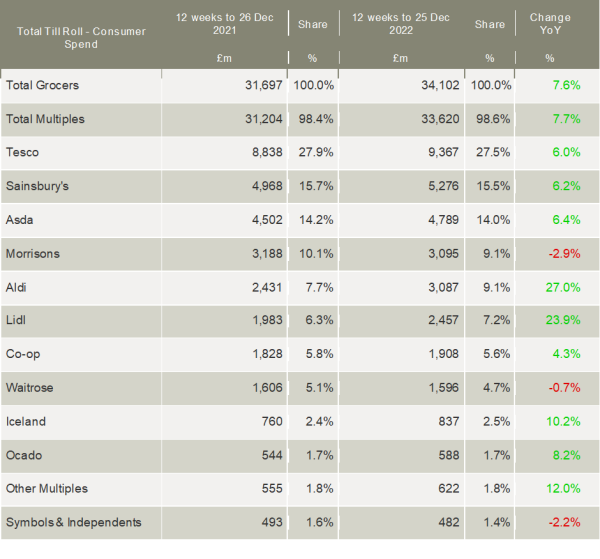Latest figures from Kantar show take-home grocery sales rose 9.4% to a record £12.8bn in the four weeks to 25 December, although growth was driven by price inflation rather than increased purchasing. Over the longer 12-week period, the rise was 7.6% with the discounters continuing to outperform the traditional supermarket giants.
Whilst value sales were £1.1bn higher in December versus the Christmas period last year, volumes were actually down by 1% year-on-year.
“This story played out across the traditional Christmas categories,” said Fraser McKevitt, head of retail and consumer insight at Kantar. “For example, value sales of mince pies soared by 19%, but volume purchases barely increased at all.”
Annual grocery price inflation stood at 14.4% during the key trading month, down slightly from 14.6% in November. McKevitt commented: “This is the second month in a row that grocery price inflation has fallen, raising hopes that the worst has now passed. However, it’s still a painfully high figure at the current rate, impacting how and what we buy at the shops.”
Kantar’s data confirmed that consumers were continuing to trade down to supermarkets’ own-label products, with sales rising by 13.3%, well ahead of a 4.7% increase in branded lines.
McKevitt said: “The British supermarket sector is more competitive than ever and the grocers are keen to retain customers by offering their own festive alternatives. This has included an emphasis on premium own-label products, giving consumers a way to treat themselves this Christmas. These lines always do well at this time of year and this festive period was no exception with sales growing by 10.2% to hit more than £700m for the first time. Tesco’s Finest range remains the single largest premium own-label line by some distance, while Aldi and Lidl were the biggest contributors to the premium own label sector’s overall growth in 2022.”
December was supermarkets’ busiest month since the start of the pandemic, with people visiting physical grocery stores 5.2% more often than this time last year.
The online grocery sector also remained in growth, with value sales up 4% year-on-year. However, there was a slight decline in online’s total share compared to Christmas 2021, nudging down by 0.6 percentage points to 11.6%.
The increase in sales values was enjoyed by almost all retailers during the festive period. The traditional grocers still captured most of the Christmas purchasing, with Tesco, Sainsbury’s, Asda and Morrisons accounting for more than two-thirds of all spending.
Asda led this group, with sales up by 6.4%, closely followed by Sainsbury’s and Tesco which achieved sales growth of 6.2% and 6.0% respectively. Despite sales falling by 2.9%, Morrisons had its best performance since June 2021, with the retailer hoping it can return to growth in the new year.
Aldi remained the fastest-growing grocer in the UK with its 27.0% increase in sales taking its market share up from 7.7% last year to 9.1%. Lidl’s sales increased by 23.9%, moving its market share up by 0.9 percentage points to 7.2%.
Iceland’s sales grew by 10.2%, with sales of frozen poultry rising by 15% and frozen prepared foods by 18%. This pushed Iceland’s market share to 2.5%. Sales at Waitrose continued to weaken, down 0.7%, with its market share slipping from 5.1% to 4.7%.

NAM Implications:
- ‘Volumes were actually down by 1% year-on-year’ – says it all for realists.
- Added to which, many consumers were having a last hurrah…
- …before knuckling down to the realities of January’s demands on their purses.
- Meanwhile “…value sales of mince pies soared by 19%, but volume purchases barely increased at all.”
- i.e. the impact of inflation needs drumming into those in the business too easily mislead by top-line figures.
- The moves to own label and the discounters are again confirmed…
- (with Aldi & Lidl continuing to grow share at the expense of the Mults and Waitrose)
- And will not easily be reversed…
- In other words, it is hopefully obvious that suppliers planning to stay outside the discounter channel…
- …are at risk.




